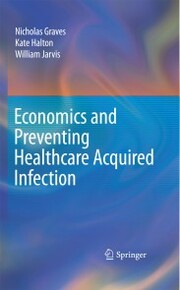-
Zusatztext
-
Reasons for Writing This Book The published literature on the economic appraisal of healthcare acquired infection (HAI) is described by phrases such as: With so many virtues of the cost-benefit approach identified, it is perhaps puzzling why greater use of economic appraisal has not been made in the area of infection control [1] Clinicians should partner with economists and policy analysts to expand and improve the economic evidence available [2] the quality of economic evaluations should be increased to inform decision makers and clinicians [3] The economics of preventing hospital-acquired infections is most often described in general terms. The underlying concepts and mechanisms are rarely made explicit but should be understood for research and policy-making [4] The aim of this book is to describe how economics should be used to inform decisi- making about infection control. Our motivation stems from the previous quotes which show economics is being used within the infection control community, but not to its full potential. Our expectation is that you do not have any formal training in economic analyses. Economic analyses have been used for many decades to argue for increased funding for hospital infection-control. In 1957, Clarke [5] investigated bed wastage in British hospitals due to Staphylococcus aureus in patients wounds. She concluded . the average length of stay in hospital of patients whose wounds were infected with Staph.
-
-
Kurztext
-
Reasons for Writing This Book The published literature on the economic appraisal of healthcare acquired infection (HAI) is described by phrases such as: "e;With so many virtues of the cost-benefit approach identified, it is perhaps puzzling why greater use of economic appraisal has not been made in the area of infection control"e; [1] "e;Clinicians should partner with economists and policy analysts to expand and improve the economic evidence available"e; [2] "e;the quality of economic evaluations should be increased to inform decision makers and clinicians"e; [3] "e;The economics of preventing hospital-acquired infections is most often described in general terms. The underlying concepts and mechanisms are rarely made explicit but should be understood for research and policy-making"e; [4] The aim of this book is to describe how economics should be used to inform decisi- making about infection control. Our motivation stems from the previous quotes which show economics is being used within the infection control community, but not to its full potential. Our expectation is that you do not have any formal training in economic analyses. Economic analyses have been used for many decades to argue for increased funding for hospital infection-control. In 1957, Clarke [5] investigated bed wastage in British hospitals due to Staphylococcus aureus in patient's wounds. She concluded .... "e;the average length of stay in hospital of patients whose wounds were infected with Staph.
-
-
Autorenportrait
- <P>Nicholas Graves is a Senior Research Fellow in Health Economics at the School of Public Health, Queensland University of Technology. He is also a Senior Lecturer in the Department of Infectious Diseases at the Princess Alexandra Hospital, Australia.</P><P>William Jarvis is a well-known figure in infection control. He was formerly Chief of the Epidemiology Branch at the CDC, as well as Director of the Hospital Infections Program at the CDC. He is a past President of The Society for Healthcare Epidemiologists of America (SHEA), and is currently Vice-President of the Association for Professionals in Infection Control (APIC).</P><P> </P>
Detailansicht
Economics and Preventing Healthcare Acquired Infection
eBook
ISBN/EAN: 9780387726519
Umbreit-Nr.: 1814055
Sprache:
Englisch
Umfang: 161 S., 6.27 MB
Format in cm:
Einband:
Keine Angabe
Erschienen am 12.06.2009
Auflage: 1/2009
E-Book
Format: PDF
DRM: Digitales Wasserzeichen


